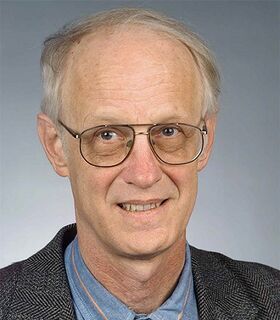Richard Van Evera Lovelace
Richard Van Evera Lovelace is an American astrophysicist and plasma physicist. Lovelace is the best known for discovery of period of pulsar in the Crab Nebula Crab pulsar), which helped to prove that pulsars are rotating neutron stars, for developing a magnetic model of jets from galaxies, and for developing a model of Rossby waves in accretion disks. He organized the US-Russia collaboration in Plasma Astrophysics, which obtained many pioneering results in modeling of plasma accretion and outflows from magnetized rotating stars.
Early life
Lovelace was born in Saint Louis on October 16, 1941. His father, Eldridge Lovelace, was a city planner, and had frequent travels to cities in the US and abroad. He often took his family with him, and Richard visited many places in the US and other countries. Father was also a specialist in parks and an artist, so that they visited many parks, museums and art galleries. Richard's mother Marjorie Van Evera Lovelace, liked to write. She wrote a book about family trips and other stories: ``Marjorie Remembers.
Richard went to John Burroughs school, where he showed talent in physics and math. He collected in a home lab different electronic equipment, and developed radios, etc. He was interested in the space program. In 1957, he observed the Soviet Sputnik, passing over Saint Louis, and together with parents, he went to Florida to observe the first launches of American spacecrafts.
Career
Lovelace was Professor at Cornell University from 1972 to 2020. He was Professor in the Department of the Applied and Engineering Physics and the Astronomy Department. He has been teaching different classes for undergraduate and graduate students. For the “Continuum Physics” class, he developed a suite of 14 demonstrations including a Venturi tube and a smoke-ring generator. See an example of experiment with fluids here inhomogeneities in rotating fluid here. With one of the students, Greg Stein, he has written a book ``Fluid Flows. He has taught for many years the graduate course on Applied Electrodynamics. Lovelace was Director of Master of Engineering Program 1991--2000. Awarded for Excellence in Teaching Prize from the Engineering Honor Society Tau Beta Pi, 1988. Lovelace was a member of the Maxwell prize committee of the [https://en.wikipedia.org/wiki/American_Physical_Society American Physical Society] 2009-2011. He was a member of the Advisory board of the Guggenheim Foundation, 1994-2005. Referee of Physical Review Letters, [1][Physics of Plasmas], Astrophysical Journal, MNRAS, Astronomy and Astrophysics 1972--2020. Divisional Associate Editor, Physical Review Letters, 1997-2000. Associate Editor for Physics of Plasmas, 2003-2019. Editorial board member: Journal of Computational Astrophysics and Cosmology, 2010 - present.
In 1991, he started the US-Russia Collaboration in Plasma Astrophysics. This collaboration helped to achieve many pioneering results in science. This is the only US-Russian collaboration in plasma astrophysics. In 2000, he initiated the US-Kazakhstan Astrophysics Collaboration, which greatly helped scientists of Kazakhstan, 2000--2004.
Research
1. In 1969, Lovelace discovered the period of the Crab Nebula pulsar, which is about P=33 ms [1]. He developed a special fast-Fourier transform program, which helped to separate the period from the noise. After this discovery, scientists concluded that pulsars are rotating neutron stars. Before that, many scientists believed that pulsars are pulsating white dwarfs. After discovering such a rapidly rotating star it become clear that it had to be a rotating neutron star \cite{LovelaceTyler2012}.
2. Proposed a model of jets from disks surrounding massive black holes in galaxies [2]. The model is based on the dynamo mechanism acting in the magnetized accretion disk surrounding a black hole or other gravitating object. The model has been widely accepted by the astronomical community and now is the main model explaining jets from galaxies, stars and planets.
3. For the first time, suggested that Rossby waves (observed in atmospheres of giant planets, such as the great red spot at Jupiter) are important in astrophysical accretion disks (e.g., \cite{LovelaceEtAl1999},\cite{LovelaceRomanova2014}). These waves form vorticies in accretion discs, where dust particles accumulate and are probable places for formation of planets (e.g., \cite{LovelaceRomanova2014}).
4. Developed the theory of the stability of electron and ion rings (e.g., \cite{Lovelace1969}). The theory is used in the current laboratory experiments on the magnetic confinement fusion (e.g., in the TAE Technologies in California).
Other Scientific Achievements
-- Proposed a new method of measuring magnetic fields. Patent: United States Patent 6,639,403 A. Temnykh, and R. V. E. Lovelace, October 28, 2003 ``System and method for sensing magnetic fields based on movement.
-- Developed pioneering theory of intense ion beams in pulsed diodes, which are currently used in laboratories. ``Generation of intense ion beams in pulsed diodes. Publication: R. N. Sudan, and R. V. Lovelace 1973, Physical Review Letters 31 (19), 1174.
-- Proposed the theory of magnetic insulation. The theory is continuously used in laboratories, for example in Sandia National Laboratory. Publication: ``Theory of magnetic insulation R. V. Lovelace, E. Ott 1974, The Physics of Fluids 17 (6), 1263-1268.
-- Invented trapping mechanism of spin-polarized neutral gas. The mechanism has been experimentally demonstrated. Publications: ``Magnetic confinement of a neutral gas R. V. E. Lovelace, C. Mehanian, T. J. Tommila, D. M. Lee 1985, Nature 318 (6041), 30-36; ~ D. Thompson, R. V. E. Lovelace, D. M. Lee ``Storage rings for spin polarized hydrogen 1989, Journal of the Optical Society of America, vol. 611.
-- Developed theory and simulations of scintillations in the interstellar medium. ``Refractive and diffractive scattering in the interstellar medium J. M. Cordes, A Pidwerbetsky, R. V. E. Lovelace The Astrophysical Journal 310, 737-767.
-- Discovered the Kolmogoroff nature of the turbulence in the Solar wind. Publication: R. V. E. Lovelace, E. E. Salpeter, L. E. Sharp, \& D. E. Harries ``Analysis of observations of interplanetary scintillations 1970, ApJ, 159, p. 1047
-- In collaboration with Russian mathematicians, developed a global, three-dimensional numerical model of the disk-accreting magnetized stars. The model is unique and does not have an analogy in the world. Many pioneering results were obtained with this 3D MHD model. This problem is important in astrophysics, because a wide variety of stars have significant magnetic fields (young stars, white dwarfs, neutron stars), and their observational properties depend on the disk-magnetosphere interaction. One of key papers: ``Three-dimensional simulations of disk accretion to an inclined dipole. II. Hot spots and variability , M. M. Romanova, G. V. Ustyugova, A. V. Koldoba, R. V. E. Lovelace 2004, The Astrophysical Journal 610 (2), 920.
-- Provided the first estimate of the electric current in the astrophysical jet: $3\times 10^{18}$ Amps. Publication: ``Measurement of the electric current in a kpc-scale jet, P. P. Kronberg, R. V. E. Lovelace, G. Lapenta, and S. A. Colgate 2011, ApJ Letters 741, L15.
Travels to Siberia
Richard liked to travel in Siberia. He climbed Altay and Sayani mountains, visited Yakuiya and Lake Baikal, climbed Avachinsky and Mutnovsky volcanos of Kamchatka.
References
Lovelace1969
http://articles.adsabs.harvard.edu//full/2012Obs...132..186L/0000186.000.html Cite error: Closing </ref> missing for <ref> tag.
Pulsars and Neutron stars
1969, Lovelace and his coauthors suggest interpretation of the already discovered pulsar (Crab nebula pulsar NP 0532) as rotating neutorn stars, that emit narrow beam of radiowaves.[3] Soon after his suggestion, such an interpretation had been confirmed [4]
References
- ↑ [http://articles.adsabs.harvard.edu//full/2012Obs...132..186L/0000186.000.html ``Crab nebula pulsar NP 0532] 1969, J. M. Comella, H. D. Craft, R. V. E. Lovelace, J. M. Sutton, G. L. Tyler Nature 221 (5179), 453-454.
- ↑ ``Dynamo model of double radio sources R. V. E. Lovelace 1976, Nature 262 (5570), 649-652..
- ↑ Crab nebula pulsar NP 0532 J.M.Comella, H.D.Craft, R.V.E.Lovelace, J.M.Sutton, G.Leonard Tyler Nature Volume 221 Issue 5179 Pages 453-454 Publication date 1969/2/1 BECAUSE of the conjecture that pulsars are neutron stars, which are possibly produced in supernova events, the possible association of pulsars with supernova remnants is of great interest. Staelin and Reifenstein recently reported1 the discovery of two pulsed radio sources near the Crab nebula, which is the remnant of the supernova observed by the Chinese in AD 1054. Pulses from both sources were described as very sporadic, and no periodic phenomena were evident.
- ↑ Private communication. 2020.
https://en.wikipedia.org/wiki/Neutron_star A neutron star is the collapsed core of a massive supergiant star, which had a total mass of between 10 and 25 solar masses, possibly more if the star was especially metal-rich.[1] Neutron stars are the smallest and densest stellar objects, excluding black holes and hypothetical white holes, quark stars, and strange stars.[2] Neutron stars have a radius on the order of 10 kilometres (6.2 mi) and a mass of about 1.4 solar masses.[3] They result from the supernova explosion of a massive star, combined with gravitational collapse, that compresses the core past white dwarf star density to that of atomic nuclei.
https://en.wikipedia.org/wiki/Pulsar A pulsar (from pulse and -ar as in quasar)[1] is a highly magnetized rotating compact star (usually neutron stars but also white dwarfs) that emits beams of electromagnetic radiation out of its magnetic poles.[2] This radiation can be observed only when a beam of emission is pointing toward Earth (much like the way a lighthouse can be seen only when the light is pointed in the direction of an observer), and is responsible for the pulsed appearance of emission. Neutron stars are very dense, and have short, regular rotational periods. This produces a very precise interval between pulses that ranges from milliseconds to seconds for an individual pulsar. Pulsars are one of the candidates for the source of ultra-high-energy cosmic rays (see also centrifugal mechanism of acceleration). // The periods of pulsars make them very useful tools for astronomers. Observations of a pulsar in a binary neutron star system were used to indirectly confirm the existence of gravitational radiation. The first extrasolar planets were discovered around a pulsar, PSR B1257+12. In 1983, certain types of pulsars were detected that at that time exceeded atomic clocks in their accuracy in keeping time.[3]
Keywords
Cornell University, Ion ring, Neutron star, Pulsar, Richard Lovelace, Scholar




